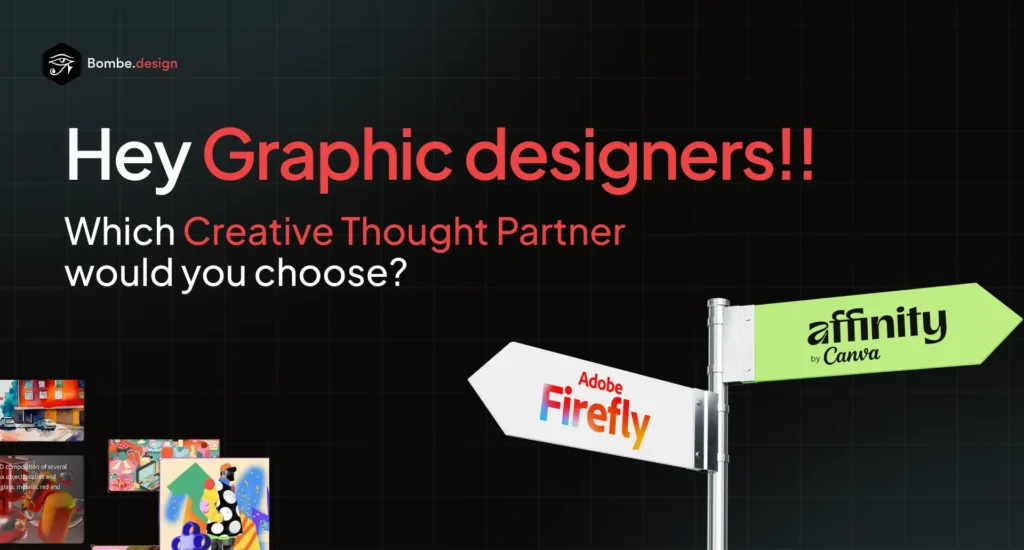In 2025, design tools are no longer just software; they’re thought partners.
The latest updates from Adobe Firefly Model 5 and Canva’s Affinity suite mark a deeper shift in creative behaviour. These aren’t simply “new features”; they’re frameworks that reshape how designers think, decide, and collaborate. This evolution isn’t about technology; it’s about human experience. It’s about freeing creative minds from friction so that intention, emotion, and storytelling can take the lead.
The Anxiety of Infinite Choice vs. The Liberation of Constraints
Modern designers face an overwhelming paradox: more tools mean more possibilities, but also more paralysis.
According to Adobe’s own creative trends survey, 99% of designers now use AI, yet many report a growing sense of fatigue from constant decision-making.
Firefly Model 5: It understands your Intentions
Firefly Model 5 tackles this by shifting control from the interface to intuition. You no longer need to navigate dozens of panels; you say what you want. Commands like “brighten the background” or “make the subject pop” trigger context-aware, non-destructive edits. It’s AI that doesn’t just follow instructions, it understands intent.
This transforms the designer’s mental model from “How do I execute this?” to “What do I actually want to create?” It’s not about automation, it’s about mental liberation.
Canva Affinity: Design That Thinks With You
Canva’s Affinity integration takes a subtler, more human approach. It limits surface complexity while deepening contextual intelligence. Drag-and-drop workflows, AI-driven fills, and GPU-accelerated rendering keep the process fast but intuitive.
For a social media manager juggling campaigns or a small business owner designing daily posts, this simplicity reduces cognitive load, the mental effort required to think through the tool. The design process becomes fluid, familiar, and confidence-driven.
Will AI Make Everything Look the Same
As generative design becomes mainstream, a new risk emerges: homogeneity.
When AI models learn from the same data, their outputs become more predictable. The challenge for UX design in 2025 isn’t creation, it’s differentiation.
Firefly combats this through custom model training and content credentials, allowing creators to embed ownership, style, and authorship. Canva counters with micro-personalization, studios that adapt to your brand’s color psychology, tone, and layout behavior.
The Confidence Gap: When AI Becomes Permission
In creative industries, skill gaps are often psychological, not technical. Many designers hesitate not because they can’t do something, but because they’re unsure if they should.
Firefly and the Validation of Expertise
Firefly’s ability to train custom models on brand assets gives teams something rare: algorithmic confidence. Every output inherently aligns with brand tone and aesthetics. For agencies, that means juniors can design at a senior quality. For brands, it means visual consistency without micromanagement. It’s not just a time-saver, it’s a confidence generator.
Affinity and the Empowerment of Simplicity
Affinity rewrites the same story for non-professionals. It gives entrepreneurs and content creators the power to produce professional-grade visuals without intimidation. Canva’s average session time of 10+ minutes and low bounce rates prove it’s not just accessible, it’s comfortably creative. Together, these tools blur the line between designer and creator. And that’s a psychological leap worth noticing.
The Collaboration Paradox: Solo Work at Scale
We talk about collaboration constantly, but the real revolution is asynchronous creativity, working independently while staying aligned as a collective. Firefly’s Project Graph allows modular, shareable workflows. Teams can co-create effects, reuse layers, and synchronize edits across campaigns without version chaos. Canva Affinity takes that ethos further, instantly publishing work across channels without leaving the interface. This integration between creation and execution removes one of design’s biggest mental drains: context-switching. The fewer steps between idea and output, the clearer the creative thinking becomes.
The Time Paradox: Faster Isn’t Enough
Firefly’s Foundry workflow and Canva’s AI suite undeniably save time, but speed alone doesn’t build loyalty. What truly keeps creators engaged is mental spaciousness, the ability to explore, iterate, and think bigger. Firefly users report not just faster rendering, but more experimentation. When the tool takes care of execution, designers rediscover their role as thinkers and storytellers. Canva offers the same gift in its own way: by turning templates and automation into enablers of creative scale.
Cognitive Architecture: The Hidden Innovation
Beneath their glossy UIs, both tools share one quiet revolution: they’re built around how humans think. Firefly reduces the gap between vision and execution for professionals; Affinity reduces the barrier between intention and output for non-specialists. Both are designed around cognitive ergonomics, making creative thought feel natural.
In other words, Firefly optimizes for depth while Affinity optimizes for flow.
Together, they represent a creative ecosystem where both mastery and accessibility can coexist.
Ready to Go Beyond the Design?
At Bombe Design, we believe the future of creativity isn’t about chasing tools, it’s about crafting meaningful experiences that connect emotion with intelligence.
Our approach merges UX thinking, AI-driven efficiency, and brand storytelling to help your ideas move from concept to impact, faster, deeper, and smarter. Let’s shape the next chapter of human-centered design beyond everything.
Collaborate with Bombe Design today and create experiences that truly move people.

